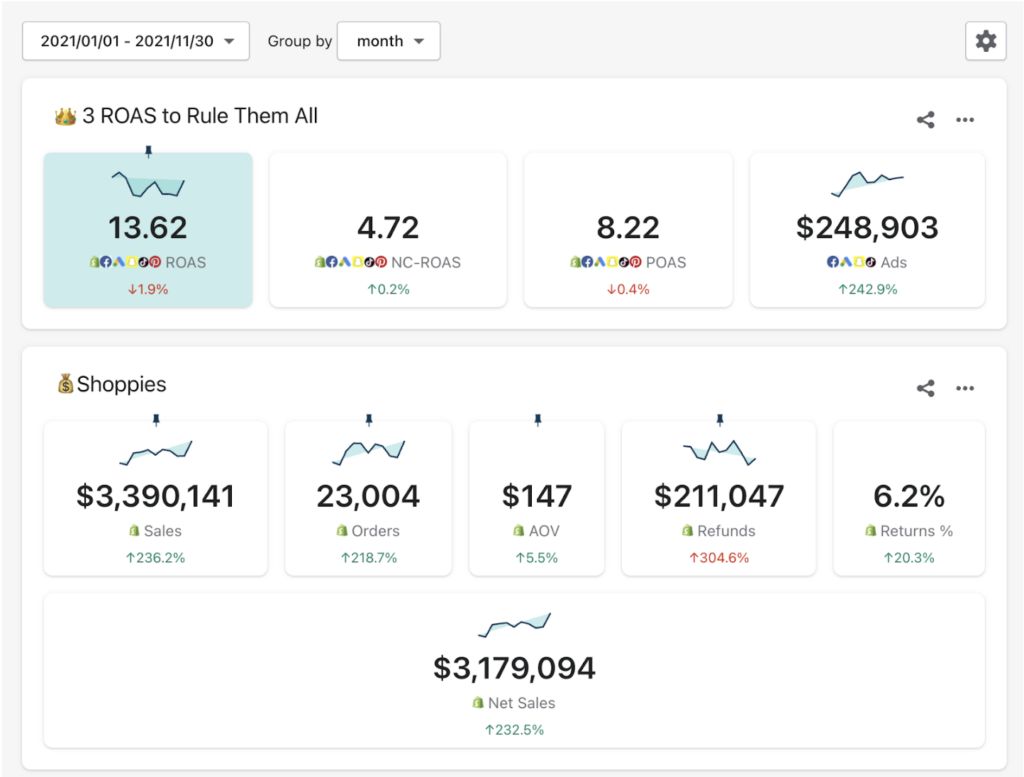
Understanding MER: Why It’s Important & How to Use It


Lots of businesses today are looking for a more complete picture of their customer journey, which means integrating and embracing a channel-agnostic strategy. That said, you still need metrics to determine if your marketing is working or not.
That’s where MER comes in.
“But wait,” you say. “What is MER, anyway?”
Good question! Especially since that’s the title of the next section…
What is MER, Anyway?
The marketing community doesn’t 100% agree on what “MER” stands for. Various interpretations include:
- Marketing Efficiency Ratio
- Marketing Effectiveness Ratio
- Media Efficiency Ratio
- Most Excellent Round-up
(That last one might be made up.)
However you label it, the metric is simple. Calculate your revenue, divide that number by your marketing spend over a given time frame, and that’s your “Marketing Efficiency Ratio”. (Or a “most excellent round-up.”)
If you remember the 3 ROAS to Rule Them All, MER is the same as eROAS.
MER = Total Revenue/Total Ad Spend
Again, we’re measuring how effective your paid media is. MER allows you to do away with abstract attribution metrics and answer a more important question — how much revenue is coming in for every dollar we spend on ads?
How to Analyze Your MER
We offer a couple of ways to display MER in the Triple Whale dashboard — as a percentage, or as a number or ratio.
MER As a Percentage
In Triple Whale, you can look at your MER as a percentage. Just click on “MER” in the section builder and you’ll see it.
The easiest way to understand what this metric is telling you is “What percentage of my revenue was used on paid media?”
In the example below, this user spent 17% of revenue on paid media.

As a Number or Ratio
You can also see MER as a value in your Triple Whale dashboard.
This is labeled Blended ROAS in the section builder (and already a part of the pre-built 3 ROAS to Rule Them All Section).
Think of this as if every dollar you make is attributed back to some sort of marketing spend.
Remember, we abstract away the attribution with MER. So as long as the money is coming in, we really don’t care where it came from. (Actually, we do, but you get the point.)
So, in this example, the MER is 13.62, which means that for every ad dollar spent, $13.62 of revenue was generated.

Benefits of MER
When you’re lost in a sea of attribution, MER is a metric you can use as your north star.
Tracking
MER is the best metric for understanding the effectiveness of your paid media at any given time.
Let’s say, for example, that you’re not sure if Facebook will drive revenue to your business.
If you’re already operating below your MER goal, you can cut back spending on the platforms you’re less confident in or launch new ads.
Either way, you know if your current paid media is still effective or starting to slip.
Planning
Let’s say that your CEO says that this year’s revenue goal is $10M.
With MER on your side, you can look at your data and say that, for example, you can reach $10M profitably with an MER of 5, or a marketing budget of 20% of your revenue goal. You can say (with confidence!) that your paid media strategy will need $2M to reach that goal.
Here’s another example. You have a new client who wants to hit $100k in revenue next month. They have a $200 Mode AOV. (Check out 3 Amigos of AOV if you don’t know what Mode AOV is.)
To calculate a target MER, we’ll need to dig into some numbers. Let’s assume that this client’s average order value is $200.
Revenue Goal/AOV = $100,000/$200 = ~ 500 Orders
Now we know that we need 500 orders next month to reach that goal.
Further, the data shows that a $30 CPA is reasonable, and the client agrees.
Finally, we calculate the budget (almost there):
Total Ad Spend = Orders * CPA = 500*$30 = $15,000
That gives us the Total Revenue and Total Ad Spend, so it’s time to nail down the target MER.
Target MER = $100,000/$15,000 = 6.67
There are a lot of assumptions behind these numbers, but this is a reasonable workflow to calculate a target MER if:
- The client generates 1+ Mode AOV per order
- Acquisition costs are a blended CAC of $30 or less
- paid media will generate all of the revenue
Finally, if you want to calculate target MER as a percentage with these numbers, you’d end up with 15%. In other words, you can spend up to 15% of revenue on paid media.
Target MER % = Total Ad Spend/Rev Goal * 100 = (15,000/100,000)*100 = 15%
What MER Doesn't Give You
We’re pro-MER here at Triple Whale, but we recognize that MER doesn’t necessarily produce actionable insights at the ad, ad set, or campaign level.
Using channel-agnostic metrics is both a feature and a bug. You get the whole picture, but you lose some of the details.
That said, you can increase visibility by simplifying campaign structures and a few other adjustments.
But for now, we hope you have a better understanding of why MER is such an important KPI, how to calculate it, and what it means.
Looking for a better understanding of your paid media and marketing performance? Try Triple Whale now!






